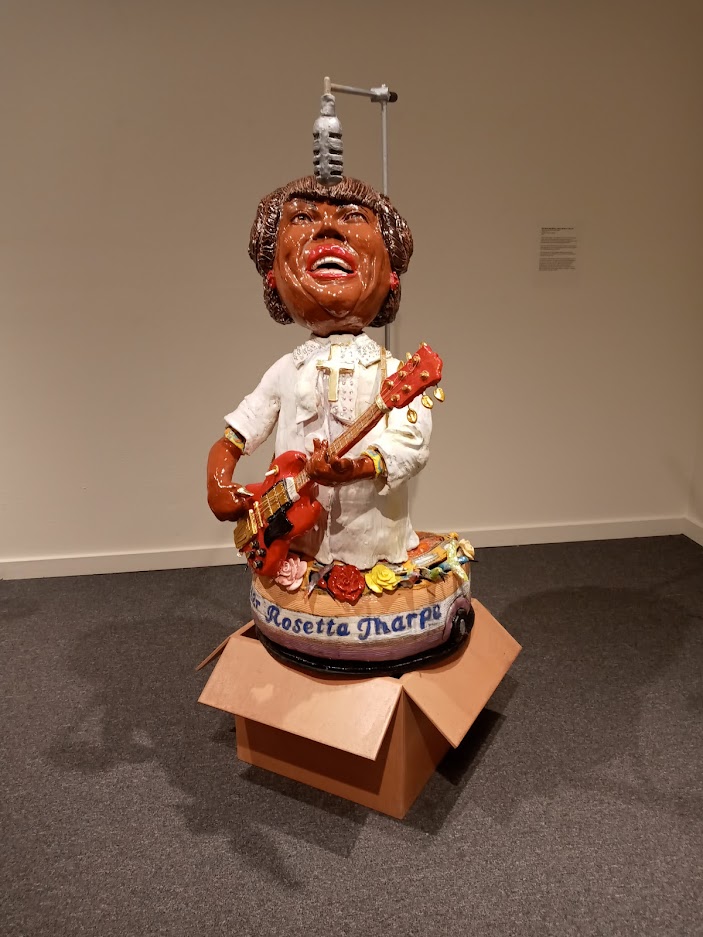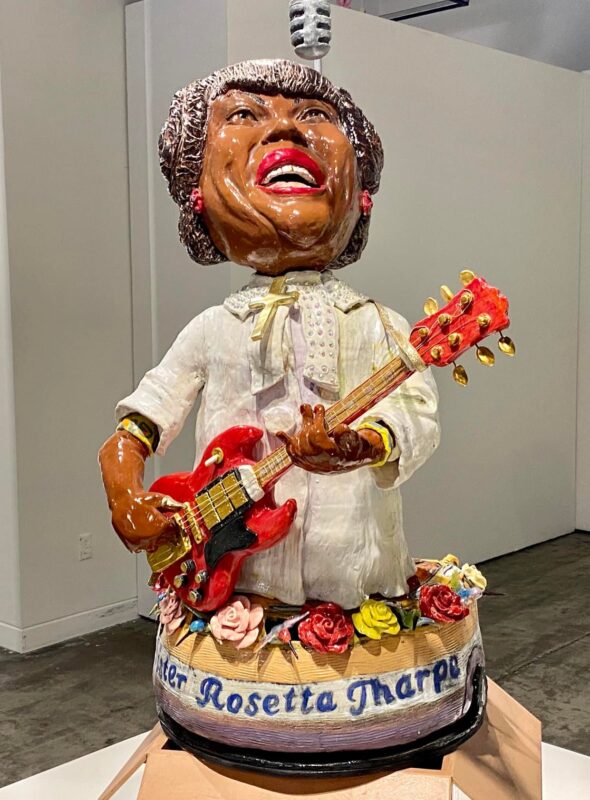“Up Above My Head, I Hear Music In The Air”
(Portrait of Sister Rosetta Tharpe)
72 x 36″ x 36″
Ceramic, Steel, and Wood
2021
Permanent collection, San Francisco Museum of Modern Art
Details
![]()

“Up Above My Head, I Hear Music In The Air”
(Portrait of Sister Rosetta Tharpe)
72 x 36″ x 36″
Ceramic, Steel, and Wood
2021
Permanent collection, San Francisco Museum of Modern Art
Details
![]()



Most of Tony’s tributes to musicians have focused on two major music categories: jazz and rock ‘n’ roll. In this portrait,
Tony also glorifies gospel and soul music. Mining historical precedents, the artist’s sculpture of Sister Rosetta Tharpe
immortalizes “The Godmother of Rock ‘n’ Roll” and “the original soul sister,” so anointed for her fusion of gospel,
rhythm-and-blues, and rock music. Sister Rosetta’s wide-ranging musical style influenced many of the musical legends
of the 20th Century, including Elvis Presley, Little Richard, B.B. King, Johnny Cash, Bob Dylan, and Aretha Franklin,
among others.
Tony first “fell in love” with Sister Rosetta Tharpe when he saw her “playing her heart out,” singing and jamming on
an electric guitar in a cameo appearance in the film Amélie, Tony’s “favorite movie of all time.” To reveal the character
and experiences of Tharpe, Tony has layered the sculpture with narrative elements to be discovered as the viewer walks
around the portrait. Seen frontally, Sister Rosetta sings into a microphone as she wails on her electric guitar, her red lips
gleaming as brightly as the red guitar with the gold-lustered strings and fretboard. Tony deliberately gave the performer
a red guitar, rather than the white 1960 Les Paul custom one on which she usually played, to denote her “devilish side”—
specifically, that the Sister had been married to three different men, but clearly was bisexual because she maintained a
longstanding relationship with singer Marie Knight, with whom she toured. This highlights one of Sister Rosetta’s dualities;
another is that she performed in churches singing spirituals during the day and rocked audiences with her rhythm
and blues in nightclubs untill closing hours. Other features that decorate the front are a row of roses and hummingbirds
that symbolize her backup bands, the Rosettes and the Dixie Hummingbirds.
Turning one’s attention to the reverse of the sculpture, Tony has anchored Sister Rosetta to a tour bus that is both coming
and going: sculpted in a “U” shape, the front and back of the bus are parallel, giving the impression that the bus is
in constant movement. This is reinforced by the Decca record on which the bus is turning. The bus is the perfect vehicle
to describe the Sister’s reality. Because of enforced segregation, most motels were off-limits to African Americans, and
therefore owning a tour bus solved the sleeping problem while on the road. Further, Sister Rosetta Tharpe was on the
road relentlessly. She was driven to earn a living and was in earnest to establish her legacy, undoubtedly boosted when
she played Carnegie Hall in 1938 and received international recognition. The bus’s rear window inscription, “Carnegie
Hall or bust,” references this now legendary performance. It should also be noted that the bus is painted in the identifying
colors of the lesbian flag – pink, orange, red and white – to symbolize Sister Rosetta Tharpe’s lesbian identity.
Having completed the walk-around, an additional feature becomes apparent: the entire portrait of Sister Rosetta, sitting
atop the bus rolling around a record, is overhanging an opened faux-cardboard box. The assemblage of a figure and
objects balancing the opened box suggests that Sister Rosetta Tharpe could not be boxed-in by conventions or preconceptions